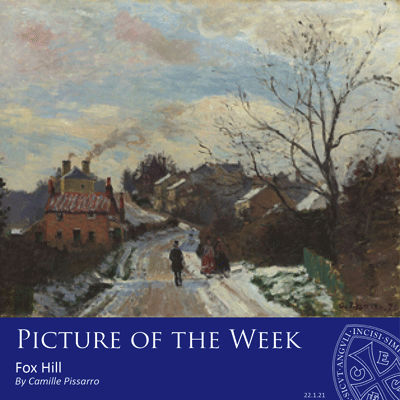Snow has fallen in certain parts of the country this week but has avoided London so far; apparently, it’s more likely to snow at Easter than at Christmas so we may get some yet and, as temperatures are still in single figures, I thought it was a good time to look at a wintry scene.
Sarah Carr Gomm, Head of History of Art
Camille Pissarro, Fox Hill, Upper Norwood, 1870, oil on canvas, 35 x 46 cm, National Gallery London
In 1870, as the Prussians advanced on Paris, both Camille Pissarro and Claude Monet fled to London. While Monet chose to live first near to Leicester Square and then at the west end of Kensington High Street so he could paint landmarks such as the newly built Houses of Parliament, Pissarro settled in rural Norwood, about 5 miles south of London, with Julie Vellay, whom he married in the Croydon Registry Office in 1871, and their two children. At the time, Norwood was not unlike Louveciennes, the village where Pissarro lived in France, and he set about painting Upper Norwood, the suburbs and the tranquil countryside that surrounded it, picking up where he’d left off.
Of course, Fox Lane today bears little resemblance to the painting except for the kink in the road. Pissarro undoubtedly altered things to suit his composition: the diagonal stream of smoke is echoed by the parallel rooftops of the houses on the right and makes a triangle with the branches of the trees. It forms an arch over the two women engaged in conversation with a top-hatted man, which he added to enliven the scene and to give a sense of scale. Pissarro arrived in England just as the first snows fell and to capture the scene as it was, he painted outside, in front of the motif – although I wonder how long he managed to stay there before freezing or, with his easel in the middle of the road, was told to move out the way by a passing cart. He saw pink in the clouds and blue in the shadows, and with a heavily laden brush and loose and speedy strokes he describes a crisp winter’s day after a snowfall. Indeed, he first exhibited the painting with the title Effet de neige / Snow Effect, which suggests that he was more interested in the atmospheric effects than the place. Pissarro was an avuncular figure in the group of artists who became known as the Impressionists, and he, along with others, taught us to delight in the world around us and the ever-changing seasons whatever the weather.














